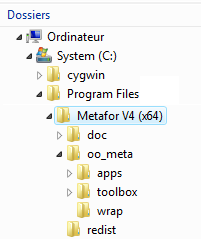This is an old revision of the document!
How to install Metafor?
Running the Installer
This video shows how to install Metafor on a Windows PC.
<html>
<iframe width=“853” height=“480” src=“www.youtube.com/embed/14Wt2mst3B0” frameborder=“0” allowfullscreen></iframe>
</html>
On Windows, just use the setup program.
* Towards the end, it is possible to install Visual C++ 2012 Microsoft run-time libraries (do so if you do not know what it is).
* Python is automatically installed with Metafor. Do not install it.
On Linux/Unix, uncompress a tarball.
===== License =====
By default, the installation program will use a “student” license which allows the user to build simulations with 5000 nodes at most.
If more nodes are needed (e.g. for Final-Year Projects), Metafor requires a license (metafor.lic file to be copied in the user directory - C:\Users\UserName on recent Windows, C:\Documents and Settings\UserName on XP, directory ~ on Linux).
To request a license, the MAC address of the computer that will run Metafor must be provided. The easiest way to get it is click on the padlock icon in the GUI (Graphical User Interface). Use the “Import” function of the padlock dialog in order to import the new license file or copy it manually to the location mentioned above.
Finally, restart Metafor, so the program can read the new license file.
===== Metafor Files =====
When installing Metafor on a computer, several directories are created:
 * doc : a snapshot of the online documentation, corresponding to the installed version of Metafor.
* oo_meta : this directory contains Metafor and its files, described below
* redist : VC++ 2012 run-time installer.
The main program of Metafor (
* doc : a snapshot of the online documentation, corresponding to the installed version of Metafor.
* oo_meta : this directory contains Metafor and its files, described below
* redist : VC++ 2012 run-time installer.
The main program of Metafor (Metafor.exe) and its DLLs are located in oo_meta. There, you can find three folders, corresponding to some Python “modules” (a module is a Python concept similar to packages in Java, or simply to libraries) :
* oo_meta/apps : contains a series of test cases. It is a set of Python files, sorted in a tree structure. To each file corresponds a test case (so each test case is a Python module).
* oo_meta/toolbox : contains Python modules which defines useful functions that will be used to create test cases. For instance, one can be used to create some simple geometries, others define some material laws, loadings, … This directory toolbox also contains a module named utilities, which includes all the main functions used to call Metafor (function meta (to start a simulation), vizu (to view a mesh), restart (to restart a simulation) …).
* oo_meta/wrap : contains modules from the “wrapper”. Those modules define the classes used by Metafor (“shadow classes”) with Python. They link together Python and the C++ code compiled within Metafor. The user should not bother himself with those files.
Now that Metafor has been installed, we must check that everything is working well.
⇒ Graphical Interface
